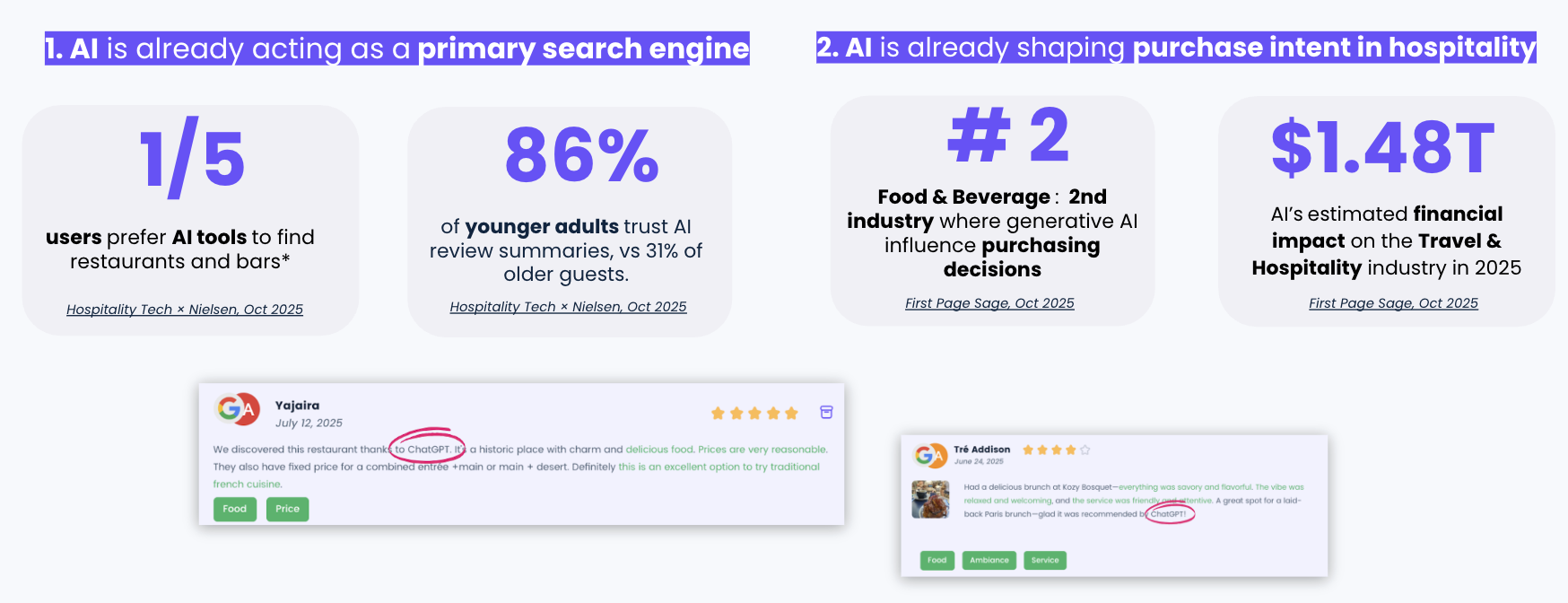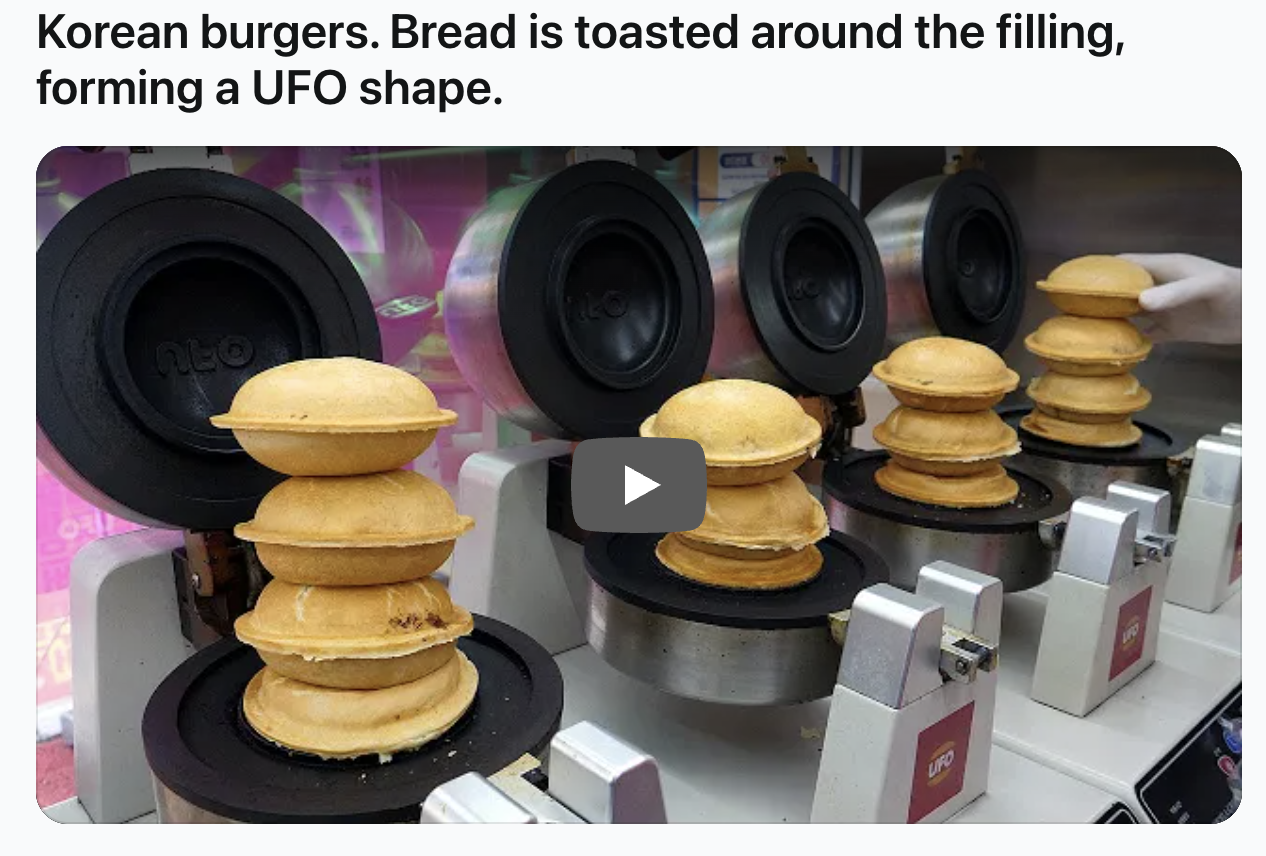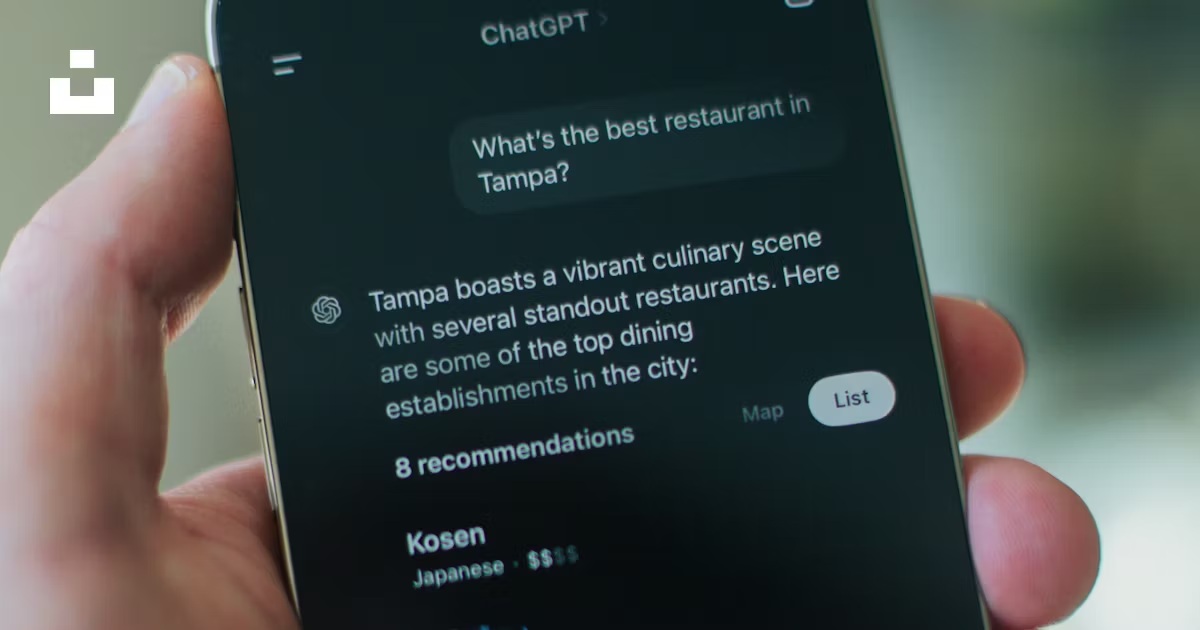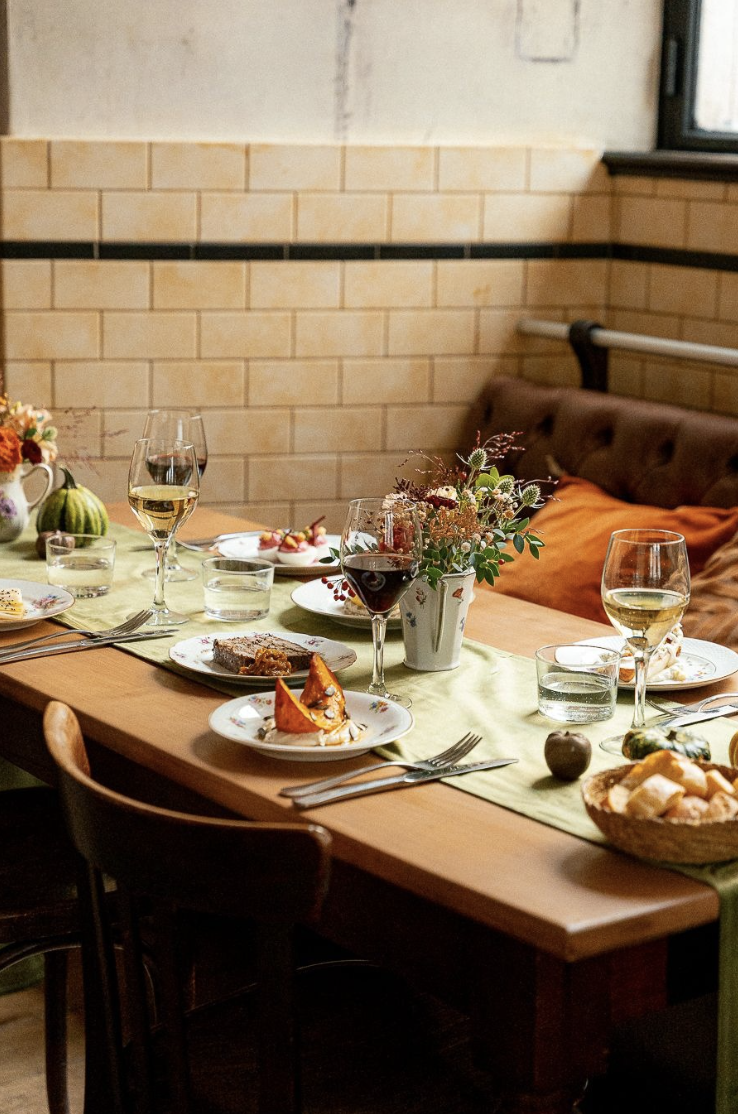
12 Food Trends To Watch In 2026 For Restaurant Groups


Find out where you stand, spot what’s holding you back, and get a custom action plan to outrank your competition.
As the restaurant industry constantly evolves, hospitality businesses need to keep their eyes open.
Each year, our experts unveil 12 major food trends—covering emerging consumer habits (like choosing locations via AI tools such as ChatGPT), food evolution (trending ingredients, industry updates), and major innovations.

The year 2026 promises to be rich in developments in the world of food. Emerging trends reflect a return to basics, a quest for memorable dining moments, increased inclusivity and a renewed openness to other culinary influences. Groups and restaurant owners are key players in this transformation—they must adapt to remain relevant and drive growth.
The key word: EXPERIENCE. Whether you run a multi-location brand, a franchise, or a small bistro, Americans are longing for unforgettable, eventful moments. Without guest experience, they will turn to takeout, catering, or fast food.
For example: even in QSR (Quick Service Restaurants) and fast-dining, some brands are making a come back thanks to their family-friendly vibe or familiar DNA like Chi-Chi's.
In this article, we explore in detail the food trends and behavioral changes that will shape 2026 and beyond—and we share practical advice to help restaurants groups & franchises adapt for better performances.
Did you know that in 2025, the best-performing groups doubled their visibility — and multiplied bookings — in just 90 days? More in our new 2025 Hospitality Groups Performances Report*.
*Based on a 12-month analysis of 2,000 restaurant locations across 254 groups, combining internal Malou performance data (SEO, reviews, engagement, visibility) with public data from Google and Instagram.
1. AI is the New Normal
Artificial Intelligence is becoming essential for restaurant management, across fields and functions.

- If you’re a heavy ChatGPT user, test these AI prompts to uncover strategic insights and profitable actions.
- If you’re not, provide AI tools with as much data as possible (brand DNA, food costs, margins).
But that’s not all. AI is changing how Americans search for restaurants. Queries are more specific (“attributes” on Google) and hyperlocal (SEO is turning into GEO). Conversational answers also feel more persuasive to online users.
Make sure all your locations show up in both Google and AI results. Use a Store Locator, collect human reviews and follow all of our pro tips to make sure your locations appear on ChatGPT and other AI.
2. Authentic Cuisine: Small Plate Renaissance
The current trend is shifting toward more traditional establishments such as bakeries, classic bistros, “bouillons,” and artisanal techniques. One word: authenticity.
Consumers prefer simple cuisine in a friendly atmosphere. Grandma’s recipes, home-cooked meals, and childhood memories are back—dethroning “overly conceptual” dining. Generous one-pot dishes to share are a win (and margin-friendly).
📈 How are groups getting more revenue with marketing and how much? Download our ebook on Digital Marketing's ROI for Restaurants !
But at the same time, we’re experiencing a Small Plates Renaissance. The ethos: tapas-style dining. Small plates, big hearts, and nights out celebrating life’s smallest—and biggest—wins.
Simplicity is complexity resolved. Feeling like you are dining at a traditional French or Spanish table is now seen as a new form of luxury.
In your restaurant: In 2026, it’s all about “open grabs”—“get a fork and dig in.” Flagship recipes include mashed sausage, roasted chicken, French aligot, rice pudding, canned sardines. If your brand DNA allows, integrate classic recipes into your menu and highlight the warmth of your location.

3. Well-being: artisanal eating in 2026
Rising concerns about health and well-being are pushing consumers away from overconsumption and processed foods. They want indulgence, but with quality seasonal ingredients, healthier artisanal cuisine, and above all—homemade.
Old recipes and classical techniques are a must.
Showcase the origin of your ingredients, your special know-how, and your local farmer’s markets online. Instagram is the perfect tool to tell your food stories and boost your local SEO.
In your restaurant: 2026 plates will feature forgotten vegetables (parsnip, salsify, Jerusalem artichoke, horseradish, black radish, turnip, chard, kale pickles), kefir, fermented products, edible flowers (especially hibiscus), and creative herb- or chili-infused butters. Adaptogenic foods such as probiotics and mushrooms should also find a place on your menu.
4. Inclusive Food & Conscious Eating (Focus: The Halal Trend)
In 2026, environmental awareness is the new normal. Food must also be more inclusive—from halal and vegan options to low-carbon practices and local community support.
Everyday dining choices are becoming acts of change. Customers are increasingly sensitive to these values, reducing meat consumption and turning to plant-based alternatives. Balance meatless options with high proteins & “Power-Up” Staples like organ-meat blends (beef + liver/heart) or whole-food protein snacks (skyr, salmon bites).
Zero-waste, mindful cuisine—fermented food, mason jars, kimchi, homemade pickles—fits perfectly and can even be sold separately. Organ-meat blends are great: margins friendly, low waste and artisanal.
In your restaurant: Customers expect seasonal products, minimalistic menus, anti-waste meals, and the full use of ingredients on their plates. Vegan and halal options are no longer optional. Transparency about product origin in your digital marketing adds strong value. Share your zero-waste initiatives or recipes to attract attention. Think upcycling, greenery, paperless systems.
For example: turning leftover bread into craft beer.

4. Foreign cuisines: New Flavors
Although International cuisine is at the core of American dining, new foreign influences are on the rise.
In 2026, food trends are diversifying, with growth in Traditional English, Eastern European, Southern Asian, and new-wave Japanese cuisines.
In your restaurant: Think pairings of high-end sushi with sake, homemade Polish pierogis, haggis and hash browns. Asian fusion is also booming thanks to third-generation entrepreneurs (e.g. the Tteok-bokki street food trend or UFO Korean burgers).

5. Ingredients: The New Shiny Things
In 2026, ingredients that photograph well, carry a story, and deliver function will win. TikTok and IG keep rewarding texture, heat, floral notes, and “better-for-you” twists—while restaurants double down on heritage flavors and snackable formats.
In 2026, you shall see a lot of whole foods and whole ingredients. Ghee fat-wash, whole-food protein (Greek Skyr or Turkish ayran yogurt). Traditional Levantine, Kurdish and Turkish cuisines are also in, like Lahmacun and Shawarma.
Umami & pantry upgrades like Sourdough brioche or crackers, gut-friendly paté, vegan charcuterie board or a Seacuterie Happy Hour with Anchovy butter toast.
NA/low-ABV pairings with kombucha, sparkling coconut/cactus waters, and NA wines to broaden inclusivity without losing craft.
A lot of tang and crunch: black lime (loomi) & hawaij as the next-gen spice rack heroes for new gens (on cocktail rims), chili-crunch toppings on veggies, tamarind & calabrian/complex chile glaze.
Hearty European dishes like cresto de gallo pasta, pintxos in small plates ("basque" tapas with a slice of cheesecake brulé), or, very minimalistic, a simple roast chicken and potatoes.
In drinks, edible wildflowers, bergamot/lemongras, shaved ice.
Pro Tip: Train your team to master quick, on-the-spot tableside carving in front of guests—for instance, a roasted chicken. It adds theater, stays simple yet elevates the dining experience.
.jpg)
6. Low-alc drinks & low-proof cocktails
“Low-ABV cocktails,” “better-for-you cocktails”—the new wave of soft drinks reflects shifting habits. Younger generations are driving demand for sessionable drinks that balance flavor with moderation.
Bars now showcase low-proof cocktails on their craft menus, along with adaptogen-based drinks and NA wines (dealcoholized wines).
In your restaurant: To satisfy all customers, offer original soft drinks, mocktails, and food-and-drink pairings. Kombucha remains a hit and adds inclusivity for non-drinkers.
.jpg)
7. Accessible Eating: Affordable & Casual
Inflation has reshaped consumers’ dining habits. Guests still want to eat out, but in more rational, budget-conscious ways. After sharp price hikes in 2025, the trend is reversing in 2026.
More affordable concepts and menus are attracting wider audiences. Even fine dining chefs are exploring more accessible offers.
In your restaurant: Redesign menus to provide more affordable choices (around $20–22), while maintaining quality. This balance will attract a broader customer base.
8. Beyond the plate: Make Way for Immersive Experience
In 2026, Customers are seeking experience, far beyond the plate.
No matter the type of restaurant you run, you need to offer memorable dining. Otherwise, potential guests will choose to order online or grab takeout instead.
In your restaurant: Attention to decor, design, kitchen location, original performances, and overall ambiance is becoming crucial.
Groups and franchises should delegate more and empower local teams to host authentic community events.
9. Pop-ups and Residences: Drivers of Attraction
More restaurants are inviting chefs to “reside” in their kitchens for limited-time menus. This attracts chef communities, entertains customers, and refreshes menus. It offers something new to your venue, as well as an amazing opportunity to communicate.
The key: keep it simple, rare, and time-limited.
In your restaurant: Choose the right leaders and craft a smart communication strategy to make temporary events impactful. Above all, amplify them online to maximize reach.
11. Fidelity: Subscription Package
Subscription plans are emerging as a way to offer a personalized experience and build customer loyalty.
In your restaurant: Consider offering subscriptions with exclusive benefits: discounts, invitations to events, or personalized perks.
It strengthens bonds and keeps customers returning, especially if you amplify these offers across social media.
12. Personalization: "My Way or the Highway"
The fast-changing landscape of consumer preferences has pushed dish personalization to the top of food trends. Restaurants now allow guests to fully customize their meals, beyond standard menus.
Wraps, bowls, burgers, salads, sushi—diners want to swap, build, and create their way.
In your restaurant: Flexibility is key to meeting evolving expectations. Guests want convenience, individuality, and choice—and personalization delivers all three.
Our Final Suggestion: Get Ready for 2026 with Malou!
What It Is: A 30-minute session with one of our experts, with a custom audit prepared in advance—covering SEO, reviews, GBP performance, and local ranking factors across your brand and locations. Then, 30 minutes of strategic insights and tailored recommendations.
Why It Matters: This is not a sales call. It’s a data-backed growth assessment—already used by groups like 8 Hospitality, Dinex, and Riviera Dining Group. Thanks to our data scientists and hospitality marketing experts, you’ll leave with a concrete strategy and a clear map of opportunities.
👉 Book your free session or call us directly: +1 (929) 494 52 10
We put The double bites to satisfy you
Increase your visibility on Google and social networks with Malou.




.jpg)
